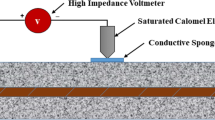Abstract
Analysis of the ways of improving the inductive method for diagnostics of the wear of tribological assemblies by the wear debris and the current state of the developments of inductive particle counters is performed. It is shown that the inductive counters based on the phenomenon of mutual electromagnetic induction that use three volumetric coils are applied to diagnose heavy loaded assemblies; however, in virtue of their restricted sensitivity to fine particles with sizes below 100 μm, the counters in question are not applicable to early diagnostics of the wear of tribological assemblies that operate under medium load and speed rates. To control the condition of the above assemblies, multichannel inductive counters can be used fitted with double-layer planar coils that record ferromagnetic and non-ferromagnetic wear debris with sizes of ≥75 μm. It is demonstrated that to date the highest sensitivity to ferromagnetic wear debris with sizes of ≥11 μm has been achieved in inductive counters the sensing coils of which have cores. The prospective application of such counters is the control at the early stage of wear of assemblies manufactured of ferromagnetic materials.
Similar content being viewed by others
References
Myshkin, N.K. and Markova, L.V., On-Line Condition Monitoring in Industrial Lubrication and Tribology, Berlin: Springer-Verlag, 2018.
Dempsey, P.J., Lewicki, D.G., and Decker, H.J., Investigation of gear and bearing fatigue damage using debris particle distributions, NASA Report no. TM-2004-212883. https://doi.org/www.dtic.mil/cgi-bin/GetTRDoc?AD=ADA426760. Accessed February 26, 2018.
Miller, J., and Kitaljevich, D., In-line oil debris monitor for aircraft engine condition assessment, IEEE Aerosp. Conf. Proc., 2000, vol. 6, pp. 49–56.
ASTM D7685-11(2016), Standard Practice for In-Line, Full Flow, Inductive Sensor for Ferromagnetic and Nonferromagnetic Wear Debris Determination and Diagnostics for Aero-Derivative and Aircraft Gas Turbine Engine Bearings, West Conshohocken, PA: ASTM Int., 2016.
Flanagan, I.M., Jordan, J.R., and Whittington, H.W., An inductive method for estimating the composition and size of metal particles, Meas. Sci. Technol., 1990, vol. 1, pp. 381–384.
Muir, D.E. and Howe, B., In-line oil debris monitor (ODM) for the advanced tactical fighter engine, Proc. Joint Conf. “Integrated Monitoring, Diagnostics, and Failure Prevention,” April 22–26, 1996, Mobile, 1996, pp. 111–118.
Dupuis, R.J., On-Line Full Flow MetalSCAN Bearing Monitoring Application Considerations, GasTOPS Report No. GTL-8-804-TI.3, 2009.
Zhan, H., Song, Y., Zhao, H., Gu, J., Yang, H., and Li, C., Study of the sensor for on-line lubricating oil debris monitoring, Sens. Transducers J., 2014, vol. 175, no. 7, pp. 214–219.
Kempster, R.W. and George, D.B., US Patent 5444367, 1995.
Markova, L.V., Myshkin, N.K., Semenyuk, M.S., Makarenko, V.M., Kolesnikov, A.V., and Kokleev, V.I., RF Patent 2234080, 2004.
Li, C. and Liang, M., Extraction of oil debris signature using integral enhanced empirical mode decomposition and correlated reconstruction, Meas. Sci. Technol., 2011, vol. 22, no. 8, art. ID 085701. doi 10.1088/0957-0233/22/8/085701
Li, C., Peng, J., and Liang, M., Enhancement of the wear particle monitoring capability of oil debris sensors using a maximal overlap discrete wavelet transform with optimal decomposition depth, Sensors, 2014, vol. 14, pp. 6207–6228. doi 10.3390/s140406207
Du, L., Zhe, J., Carletta, J., Veillette, R., and Choy, F., Real-time monitoring of wear debris in lubrication oil using a microfluidic inductive Coulter counting device, Microfluid. Nanofluid., 2010, vol. 9, no. 6, pp. 1241–1245.
Du, L. and Zhe, J., Parallel sensing of metallic wear debris in lubricants using undersampling data processing, Tribol. Int., 2012, vol. 53, pp. 28–34.
Hong, W., Wang, S., Tomovic, M., Liu, H., and Wang, X., A new debris sensor based on dual excitation sources for online debris monitoring, Meas. Sci. Technol., 2015, vol. 26, no. 9, art. ID 095101. doi 10.1088/0957-0233/26/9/095101
Zhu, X., Zhong, C., and Zhe, J., A high sensitivity wear debris sensor using ferrite cores for online oil condition monitoring, Meas. Sci. Technol., 2017, vol. 28, no. 7, art. ID 075102. doi 10.1088/1361-6501
Author information
Authors and Affiliations
Corresponding author
Additional information
Original Russian Text © L.V. Markova, 2018, published in Trenie i Iznos, 2018, Vol. 39, No. 4, pp. 333–343.
About this article
Cite this article
Markova, L.V. Diagnostics of the Wear of Tribological Assemblies Using an Inductive Wear Debris Counter. J. Frict. Wear 39, 265–273 (2018). https://doi.org/10.3103/S1068366618040104
Received:
Published:
Issue Date:
DOI: https://doi.org/10.3103/S1068366618040104




